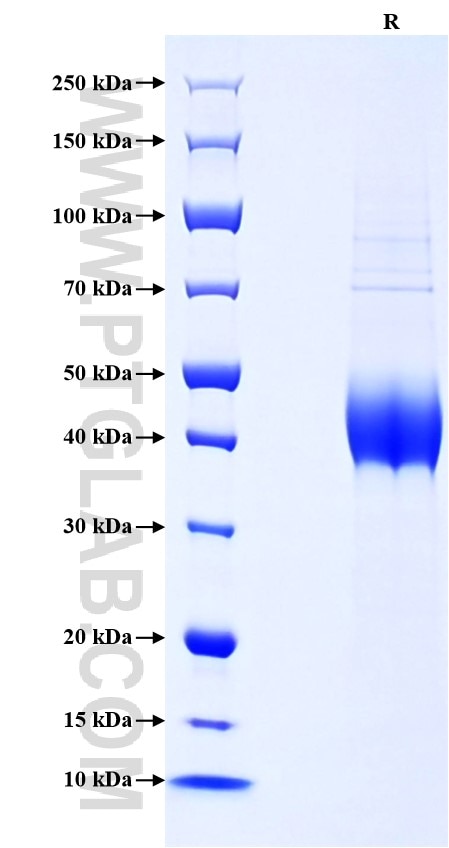Recombinant Human TFPI protein (His Tag)
Species
Human
Purity
>90 %, SDS-PAGE
Tag
His Tag
Activity
not tested
Cat no : Eg0855
Validation Data Gallery
Product Information
| Purity | >90 %, SDS-PAGE |
| Endotoxin | <0.1 EU/μg protein, LAL method |
| Activity |
Not tested |
| Expression | HEK293-derived Human TFPI protein Asp29-Lys282 (Accession# P10646-1) with a His tag at the C-terminus. |
| GeneID | 7035 |
| Accession | P10646-1 |
| PredictedSize | 30.8 kDa |
| SDS-PAGE | 38-50 kDa, reducing (R) conditions |
| Formulation | Lyophilized from 0.22 μm filtered solution in PBS, pH 7.4. Normally 5% trehalose and 5% mannitol are added as protectants before lyophilization. |
| Reconstitution | Briefly centrifuge the tube before opening. Reconstitute at 0.1-0.5 mg/mL in sterile water. |
| Storage Conditions |
It is recommended that the protein be aliquoted for optimal storage. Avoid repeated freeze-thaw cycles.
|
| Shipping | The product is shipped at ambient temperature. Upon receipt, store it immediately at the recommended temperature. |
Background
Tissue factor pathway inhibitor (TFPI) is a critical anticoagulant protein present in endothelium and platelets. TFPI is produced as two major isoforms in humans, TFPIa and TFPIb that result from alternative splicing. The TFPIb isoform localizes to the endothelium surface where it is a potent inhibitor of tissue factor-factor VIIa complexes that initiate blood coagulation. The TFPIa isoform is present in platelets. TFPI is a Kunitz-type serine protease inhibitor that exerts anticoagulant activity by blocking early procoagulant stimulia. TFPI can enhance anti-thrombotic treatment in sepsis, inflammatory diseases, and cardiovascular diseases. In plasma, 80% of TFPI is carboxy-terminal truncated and circulates bound primarily to low-density lipoproteins (LDL), with the levels of the latter having an impact on plasma TFPI levels. The other 20% is unbound free-form TFPI characterised by the K3 domain.
References:
1. Alan E Mast. et al. (2016) Arterioscler Thromb Vasc Biol. 36(1):9-14. 2. Jeremy P Wood. et al. (2014) Blood. 123(19):2934-43. 3. N L Sanders. et al. (1985) Blood. 66(1):204-12. 4. Lwaleed BA. et al. (2006) J Pathol. 208(3): 327-39.

